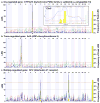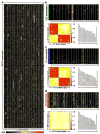Genome-level analysis of genetic regulation of liver gene expression networks
- PMID: 17542012
- PMCID: PMC3518845
- DOI: 10.1002/hep.21682
Genome-level analysis of genetic regulation of liver gene expression networks
Abstract
The liver is the primary site for the metabolism of nutrients, drugs, and chemical agents. Although metabolic pathways are complex and tightly regulated, genetic variation among individuals, reflected in variations in gene expression levels, introduces complexity into research on liver disease. This study dissected genetic networks that control liver gene expression through the combination of large-scale quantitative mRNA expression analysis with genetic mapping in a reference population of BXD recombinant inbred mouse strains for which extensive single-nucleotide polymorphism, haplotype, and phenotypic data are publicly available. We profiled gene expression in livers of naive mice of both sexes from C57BL/6J, DBA/2J, B6D2F1, and 37 BXD strains using Agilent oligonucleotide microarrays. These data were used to map quantitative trait loci (QTLs) responsible for variations in the expression of about 19,000 transcripts. We identified polymorphic local and distant QTLs, including several loci that control the expression of large numbers of genes in liver, by comparing the physical transcript position with the location of the controlling QTL.
Conclusion: The data are available through a public web-based resource (www.genenetwork.org) that allows custom data mining, identification of coregulated transcripts and correlated phenotypes, cross-tissue, and cross-species comparisons, as well as testing of a broad array of hypotheses.
Conflict of interest statement
The authors declare they have no competing financial interest.
Figures






Similar articles
-
Using gene expression databases for classical trait QTL candidate gene discovery in the BXD recombinant inbred genetic reference population: mouse forebrain weight.BMC Genomics. 2008 Sep 25;9:444. doi: 10.1186/1471-2164-9-444. BMC Genomics. 2008. PMID: 18817551 Free PMC article.
-
Transcriptome networks in the mouse retina: An exon level BXD RI database.Mol Vis. 2015 Oct 26;21:1235-51. eCollection 2015. Mol Vis. 2015. PMID: 26604663 Free PMC article.
-
Complex trait analysis of gene expression uncovers polygenic and pleiotropic networks that modulate nervous system function.Nat Genet. 2005 Mar;37(3):233-42. doi: 10.1038/ng1518. Epub 2005 Feb 13. Nat Genet. 2005. PMID: 15711545
-
Cis-acting expression quantitative trait loci in mice.Genome Res. 2005 May;15(5):681-91. doi: 10.1101/gr.3216905. Epub 2005 Apr 18. Genome Res. 2005. PMID: 15837804 Free PMC article.
-
Identification of pathways for atherosclerosis in mice: integration of quantitative trait locus analysis and global gene expression data.Circ Res. 2007 Aug 3;101(3):e11-30. doi: 10.1161/CIRCRESAHA.107.152975. Epub 2007 Jul 19. Circ Res. 2007. PMID: 17641228
Cited by
-
Replication and narrowing of gene expression quantitative trait loci using inbred mice.Mamm Genome. 2009 Jul;20(7):437-46. doi: 10.1007/s00335-009-9199-0. Epub 2009 Jul 17. Mamm Genome. 2009. PMID: 19609828 Free PMC article.
-
Dietary restriction reveals sex-specific expression of the mTOR pathway genes in Japanese quails.Sci Rep. 2024 Apr 9;14(1):8314. doi: 10.1038/s41598-024-58487-9. Sci Rep. 2024. PMID: 38594358 Free PMC article.
-
Systems genetics of metabolism: the use of the BXD murine reference panel for multiscalar integration of traits.Cell. 2012 Sep 14;150(6):1287-99. doi: 10.1016/j.cell.2012.08.012. Epub 2012 Aug 30. Cell. 2012. PMID: 22939713 Free PMC article.
-
Sex-specific gene expression in the BXD mouse liver.Physiol Genomics. 2010 Aug;42(3):456-68. doi: 10.1152/physiolgenomics.00110.2009. Epub 2010 Jun 15. Physiol Genomics. 2010. PMID: 20551147 Free PMC article.
-
SYSGENET: a meeting report from a new European network for systems genetics.Mamm Genome. 2010 Aug;21(7-8):331-6. doi: 10.1007/s00335-010-9273-7. Epub 2010 Jul 11. Mamm Genome. 2010. PMID: 20623354 Free PMC article.
References
-
- Brem RB, Yvert G, Clinton R, Kruglyak L. Genetic dissection of transcriptional regulation in budding yeast. Science. 2002;296:752–755. - PubMed
-
- Schadt EE, Monks SA, Drake TA, Lusis AJ, Che N, Colinayo V, et al. Genetics of gene expression surveyed in maize, mouse and man. Nature. 2003;422:297–302. - PubMed
-
- Chesler EJ, Lu L, Shou S, Qu Y, Gu J, Wang J, et al. Complex trait analysis of gene expression uncovers polygenic and pleiotropic networks that modulate nervous system function. Nat Genet. 2005;37:233–242. - PubMed
-
- Waring JF, Jolly RA, Ciurlionis R, Lum PY, Praestgaard JT, Morfitt DC, et al. Clustering of hepatotoxins based on mechanism of toxicity using gene expression profiles. Toxicol Appl Pharmacol. 2001;175:28–42. - PubMed
Publication types
MeSH terms
Grants and funding
LinkOut - more resources
Full Text Sources
Other Literature Sources
Molecular Biology Databases
